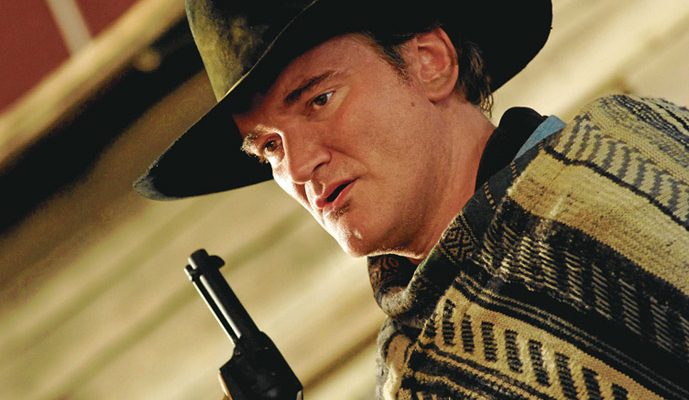Quentin Tarantino arrived at the Sundance Film Festival with “Reservoir Dogs” under his arm in January 1992. His verbose, violent ode to gangster movies, Hong Kong thrillers, and French New Wave style immediately defined a primary American film movement of the 1990s. This month sees the release of “The Hateful Eight;” it’s the eighth film (or ninth, if we count the two halves of “Kill Bill” as truly separate movies) in a career that also features a number of Tarantino-penned scripts in which characters he created appeared under the guidance of other directors.
Tarantino’s films consistently prove the importance of character over spectacle or plot. The twists of “Pulp Fiction” are certainly entertaining, but we go back to the movie on a regular basis as a chance to spend time with characters like Jules and Vincent. Here, we’ve ranked the 50 most memorable characters from Tarantino’s films and scripts.
50. The Gimp – “Pulp Fiction” (1994)
More a creature of leather than of flesh, this grunting sub is barely a character in any classic sense. But what a presence! This permanent resident of a scuzzy pawn-shop dungeon —by choice, maybe?— is a neon sign proclaiming “shit’s about to get WEIRD.” Message received, Gimp.
49. Mr. Brown – “Reservoir Dogs” (1992)
The cast of “Reservoir Dogs” features a stellar cast of character actors, but who gets the first line? Tarantino himself, as a criminal sideman whose principal contribution to the movie is a vulgar monologue about “Like a Virgin.” Even if you can’t remember another thing he says, that opening is crucial as a statement of purpose not just for this film, but for Tarantino’s career.

48. Seth Gecko – “From Dusk Till Dawn” (1996)
This coldly calculating, smoky-eyed killer could have been merely the sober straight man to his demented brother in the film, but Tarantino and Robert Rodriguez landed George Clooney for the role. The future big-time movie star, then “merely” a small-screen heartthrob on “E.R.,” amplified Seth’s charms, creating an unlikely pulp horror anti-hero.
47. Captain Koons – “Pulp Fiction” (1994)
It’s not so difficult to leave an indelible mark on an audience; all it takes is a story about hiding an uncomfortable hunk of metal up your ass for years. Tarantino’s characters can be impossible to differentiate from the performances that lift them off the page, and Christopher Walken’s performance as a war hero-turned-fairy godfather is a pristine example of character and actor intertwined.
46. Fredrick Zoller – “Inglourious Basterds” (2009)
This kid got lucky, if by “lucky” you count killing hundreds of enemy soldiers with one rifle while taking refuge in a tower (perversely, the model for Zoller is US Army veteran Audie Murphy). Heralded as a model of Nazi determination by Goebbels, Zoller lets his war hero status go to his head. He’s not creepy because he’s a Nazi, but because he wields his fame like a weapon against Shoshanna.
45. K-Billy DJ – “Reservoir Dogs” (1992)
We don’t even need to see Steven Wright. His nasally sonorous voice and snail’s-pace delivery fleshes out this disembodied DJ just fine. Wright’s on-air rambling —“chatter” would imply a velocity he never achieves— is a sort of set dressing that paints in the sundown ‘70s vibe of Tarantino’s imagined world. Thanks in part to the soundtrack release, which featured Wright’s intros along with the songs, we can’t imagine this story without him.
 44. Bridget von Hammersmarck – “Inglourious Basterds” (2009)
44. Bridget von Hammersmarck – “Inglourious Basterds” (2009)
A German silver-screen star turned spy for the Allies attempts to make the best of a bad situation, going so far as to pursue a foolish ruse with a gunshot leg. The bonehead Basterds, after all, may be crack commandoes on the battlefield, but they have a few handicaps in more subtle situations. You’ve gotta admire this agent’s guts, as she’s obviously screwed the moment she steps into the “Nation’s Pride” premiere.
43. Major Hellstrom – “Inglourious Basterds” (2009)
The very image of an imposing SS Officer, Hellstrom is a worryingly perceptive Nazi. His grim intensity suggests he is capable of lightning-quick bursts of violence long before we see his skills in acton. He’s like an experimental machine designed to generate high-test suspense. That, combined with a tendency towards perverse humor, makes him a potent force even in small doses.
42. Joe Cabot – “Reservoir Dogs” (1992)
Off-screen bruiser and alcoholic Lawrence Tierney brings rumpled cred to Tarantino’s gangster debut. At his advanced age, the hair-trigger irritability of this growling crime boss no longer always explodes into violence, but he’s still got Eddie and Vince Vega around as muscle. And as the film’s conclusion shows, Joe remains a cold-blooded triggerman at heart.
 41. Honey Bunny – “Pulp Fiction” (1994)
41. Honey Bunny – “Pulp Fiction” (1994)
There are only two women in “Reservoir Dogs” —both are briefly-seen carjacking victims— but Tarantino opens his followup with this intriguing bundle of nerves who can swing on a dime from intently perceptive to viciously confrontational. With only a few minutes and a handful of lines, Amanda Plummer turns this small-time criminal into one of Pulp Fiction’s most memorable personalities.

